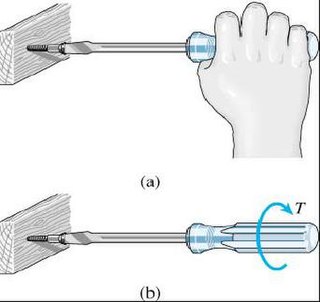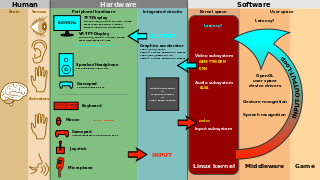Software documentation is written text or illustration that accompanies computer software or is embedded in the source code. The documentation either explains how the software operates or how to use it, and may mean different things to people in different roles.
Documentation is any communicable material that is used to describe, explain or instruct regarding some attributes of an object, system or procedure, such as its parts, assembly, installation, maintenance and use. Documentation can be provided on paper, online, or on digital or analog media, such as audio tape or CDs. Examples are user guides, white papers, online help, and quick-reference guides. Paper or hard-copy documentation has become less common. Documentation is often distributed via websites, software products, and other online applications.

Usability can be described as the capacity of a system to provide a condition for its users to perform the tasks safely, effectively, and efficiently while enjoying the experience. In software engineering, usability is the degree to which a software can be used by specified consumers to achieve quantified objectives with effectiveness, efficiency, and satisfaction in a quantified context of use.
A technical writer is a professional information communicator whose task is to transfer information between two or more parties, through any medium that best facilitates the transfer and comprehension of the information. Technical writers research and create information through a variety of delivery media. Example types of information include online help, manuals, white papers, design specifications, project plans and software test plans. With the rise of e-learning, technical writers are increasingly becoming involved with creating online training material. Source data premisable if understood and tangible
Implementation is the realization of an application, or execution of a plan, idea, model, design, specification, standard, algorithm, or policy.

In systems engineering and software engineering, requirements analysis focuses on the tasks that determine the needs or conditions to meet the new or altered product or project, taking account of the possibly conflicting requirements of the various stakeholders, analyzing, documenting, validating and managing software or system requirements.
Knowledge workers are workers whose main capital is knowledge. Examples include programmers, physicians, pharmacists, architects, engineers, scientists, design thinkers, public accountants, lawyers, and academics, whose job is to "think for a living".
Technical writing is writing or drafting technical communication used in technical and occupational fields, such as computer hardware and software, engineering, chemistry, aeronautics, robotics, finance, medical, consumer electronics, biotechnology, and forestry. Technical writing encompasses the largest sub-field in technical communication.
Technical communication is a means to convey scientific, engineering, or other technical information. Individuals in a variety of contexts and with varied professional credentials engage in technical communication. Some individuals are designated as technical communicators or technical writers. These individuals use a set of methods to research, document, and present technical processes or products. Technical communicators may put the information they capture into paper documents, web pages, computer-based training, digitally stored text, audio, video, and other media. The Society for Technical Communication defines the field as any form of communication that focuses on technical or specialized topics, communicates specifically by using technology or provides instructions on how to do something. More succinctly, the Institute of Scientific and Technical Communicators defines technical communication as factual communication, usually about products and services. The European Association for Technical Communication briefly defines technical communication as "the process of defining, creating and delivering information products for the safe, efficient and effective use of products ".
Audience analysis is a task that is often performed by technical writers in a project's early stages. It consists of assessing the audience to make sure the information provided to them is at the appropriate level. The audience is often referred to as the end-user, and all communications need to be targeted towards the defined audience. Defining an audience requires the consideration of many factors, such as age, culture and knowledge of the subject. After considering all the known factors, a profile of the intended audience can be created, allowing writers to write in a manner that is understood by the intended audience.
Task analysis is the analysis of how a task is accomplished, including a detailed description of both manual and mental activities, task and element durations, task frequency, task allocation, task complexity, environmental conditions, necessary clothing and equipment, and any other unique factors involved in or required for one or more people to perform a given task.
A subject-matter expert (SME) is a person who is an authority in a particular area or topic.

User interface (UI) design or user interface engineering is the design of user interfaces for machines and software, such as computers, home appliances, mobile devices, and other electronic devices, with the focus on maximizing usability and the user experience. The goal of user interface design is to make the user's interaction as simple and efficient as possible, in terms of accomplishing user goals.
Software project management is an art and science of planning and leading software projects. It is a sub-discipline of project management in which software projects are planned, implemented, monitored and controlled.
Virtual engineering (VE) is defined as integrating geometric models and related engineering tools such as analysis, simulation, optimization, and decision making tools, etc., within a computer-generated environment that facilitates multidisciplinary collaborative product development. Virtual engineering shares many characteristics with software engineering, such as the ability to obtain many different results through different implementations.
Guided selling is a process that helps potential buyers of products or services to choose the product best fulfilling their needs and hopefully guides the buyer to buy. It also helps vendors of products to actively guide their customers to a buying decision and thus increases their conversion rate.
Work system has been used loosely in many areas. This article concerns its use in understanding IT-reliant systems in organizations. A notable use of the term occurred in 1977 in the first volume of MIS Quarterly in two articles by Bostrom and Heinen (1977). Later Sumner and Ryan (1994) used it to explain problems in the adoption of CASE. A number of socio-technical systems researchers such as Trist and Mumford also used the term occasionally, but seemed not to define it in detail. In contrast, the work system approach defines work system carefully and uses it as a basic analytical concept.
Technical translation is a type of specialized translation involving the translation of documents produced by technical writers, or more specifically, texts which relate to technological subject areas or texts which deal with the practical application of scientific and technological information. While the presence of specialized terminology is a feature of technical texts, specialized terminology alone is not sufficient for classifying a text as "technical" since numerous disciplines and subjects which are not "technical" possess what can be regarded as specialized terminology. Technical translation covers the translation of many kinds of specialized texts and requires a high level of subject knowledge and mastery of the relevant terminology and writing conventions.

A view model or viewpoints framework in systems engineering, software engineering, and enterprise engineering is a framework which defines a coherent set of views to be used in the construction of a system architecture, software architecture, or enterprise architecture. A view is a representation of a whole system from the perspective of a related set of concerns.
SAP implementation refers to the name of the German company SAP SE, and is the whole of processes that defines a method to implement the SAP ERP enterprise resource planning software in an organization. The SAP implementation method described in this entry is a generic method and not a specific implementation method as such. It is based on best practices and case studies from various literature sources and presents a collection of processes and products that make up a complete implementation method to allow any organization to plan and execute the implementation of SAP software.